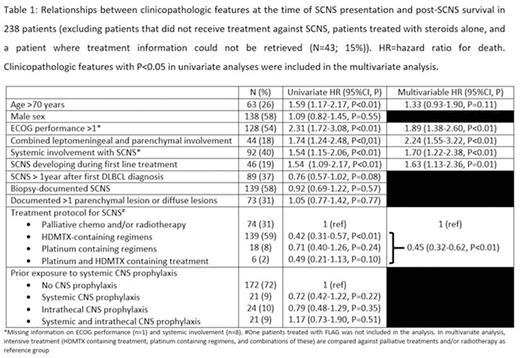Abstract
Background: Secondary CNS involvement (SCNS) is a detrimental complication seen in ~5% of patients with diffuse large B-cell lymphoma (DLBCL) treated with modern immunochemotherapy. Data from older series report short survival following SCNS, typically <6 months. However, data in patients that develop SCNS following primary therapy that contains a rituximab-based-regimen as well as the impact of more intensified treatment for SCNS are limited.
Aims: The aims of this study were to i) describe the natural history of SCNS in a large cohort of patients treated with immunochemotherapy, and ii) determine prognostic factors after SCNS.
Patients and methods: We performed a retrospective study of patients diagnosed with SCNS during or after frontline immunochemotherapy (R-CHOP or equivalently effective regimens). SCNS was defined as new involvement of the CNS (parenchymal, leptomeningeal, and/or eye) in patients without known CNS involvement at the time of first pathologic diagnosis of DLBCL. Patients were identified from local databases and/or regional/national registries in Denmark, Canada (British Columbia), Australia, Israel, US (University of Iowa/Mayo Clinic SPORE), and England (Guy's and St. Thomas' Hospital, London). Clinico-pathologic and treatment characteristics at the time of SCNS were collected from medical records.
Results: In total, 281 patients with SCNS diagnosed between 2001 and 2016 were included. Median age at SCNS was 64 (range 20-93) years and male:female ratio was 1.3. SCNS occurred as part of first relapse in 244 (87%) patients and 112 (40%) had documented concurrent systemic disease at the time of SCNS. The median time from initial DLBCL diagnosis to SCNS was 9 months, which was similar for patients treated with (N=76, 27%) or without upfront CNS prophylaxis (N=205, 73%) (10 vs 9 Mo; P=0.3). The median post-SCNS OS was 4 months (interquartile range 2-13) and the 2yr survival rate was 20% (95% CI 15-25) for the entire cohort. Associations between clinicopathologic features, management strategy, and post-SCNS survival are shown in Table 1, which excludes patients who did not receive any treatment against SCNS, patients treated with steroids alone, and a patient with unavailable treatment information (n=43, 15%). In multivariable analysis, performance status >1, concurrent leptomeningeal and parenchymal involvement, SCNS developing before completion of 1st line treatment, and combined systemic and CNS involvement by DLBCL were associated with inferior outcomes. Upfront CNS prophylaxis did not influence post-SCNS OS. High-dose methotrexate (HDMTX) and/or platinum based treatment regimens (i.e. ICE, DHAP, or GDP [+/- IT treatment and/or radiotherapy], N=163) for SCNS were associated with reduced risk of death (HR 0.45 [0.32-0.62, P<0.01]). The 2yr post-SCNS survival for patients treated with HDMTX and/or platinum-based regimens (N=163) was 29% (95% CI 22-37). For patients with isolated parenchymal SCNS, single modality treatment with radiotherapy resulted in 2-yr OS of 19% (95% CI 8-35). For the subgroup of 49 patients treated with HDMTX- and/or platinum-based regimens for isolated SCNS after 1st line DLBCL treatment and with performance status 0 or 1, the 2yr post-SCNS survival was 46% (95% CI 31-59). Overall, 9% of the patients received HDT with ASCT as part of salvage therapy at the time of SCNS. Amongst 36 SCNS patients without systemic involvement and in CR following intensive treatment (HDMTX and/or platinum-based treatments), 11 patients consolidated with HDT had similar outcomes to 25 patients treated without consolidating HDT (P=0.9, Fig 1)
Conclusions: Outcomes for patients with SCNS remain poor in this large international cohort of patients from the immunochemotherapy era. Combined parenchymal and leptomeningeal disease, presence of systemic disease concurrent with SCNS, performance status >1, and SCNS developing during first line treatment were independently associated with inferior OS. However, a significant fraction of patients with isolated SCNS after first line DLBCL treatment and with good performance status may achieve long-term remissions after intensive regimens for SCNS.
El-Galaly:Roche: Consultancy, Other: travel funding. Cheah:Bristol Myers Squibb: Membership on an entity's Board of Directors or advisory committees; Gilead Sciences: Membership on an entity's Board of Directors or advisory committees; Janssen-Cilag: Membership on an entity's Board of Directors or advisory committees, Other: Speaker's Bureau. Kansara:Celgene: Honoraria. Connors:Bristol Myers Squib: Research Funding; NanoString Technologies: Research Funding; F Hoffmann-La Roche: Research Funding; Millennium Takeda: Research Funding; Seattle Genetics: Research Funding. Sehn:roche/genentech: Consultancy, Honoraria; amgen: Consultancy, Honoraria; seattle genetics: Consultancy, Honoraria; abbvie: Consultancy, Honoraria; TG therapeutics: Consultancy, Honoraria; celgene: Consultancy, Honoraria; lundbeck: Consultancy, Honoraria; janssen: Consultancy, Honoraria. Opat:Roche: Consultancy, Honoraria, Other: Provision of subsidised drugs, Research Funding. Seymour:Genentech: Consultancy, Honoraria, Membership on an entity's Board of Directors or advisory committees, Research Funding; AbbVie Inc.: Consultancy, Honoraria, Membership on an entity's Board of Directors or advisory committees, Research Funding, Speakers Bureau; Roche: Consultancy, Honoraria, Membership on an entity's Board of Directors or advisory committees, Speakers Bureau; Janssen: Consultancy, Honoraria, Membership on an entity's Board of Directors or advisory committees, Research Funding, Speakers Bureau; Celgene: Consultancy, Honoraria, Membership on an entity's Board of Directors or advisory committees, Speakers Bureau; Takeda: Honoraria, Membership on an entity's Board of Directors or advisory committees; Gilead: Consultancy, Honoraria, Membership on an entity's Board of Directors or advisory committees, Speakers Bureau. Villa:Celgene: Honoraria; Lundbeck: Honoraria; Roche: Honoraria, Research Funding.
Author notes
Asterisk with author names denotes non-ASH members.



This feature is available to Subscribers Only
Sign In or Create an Account Close Modal